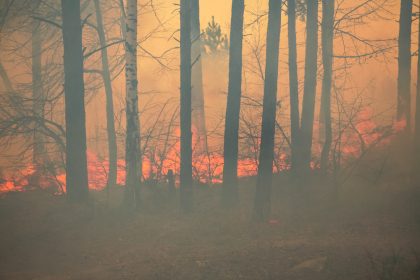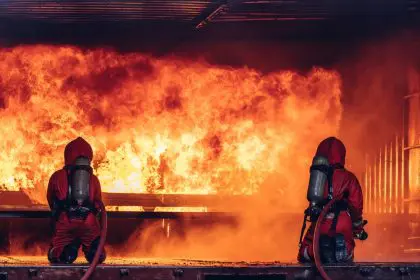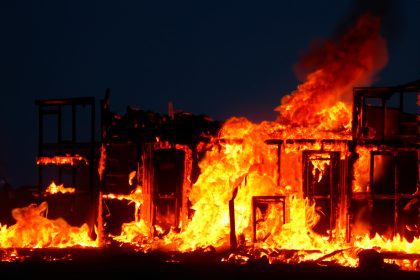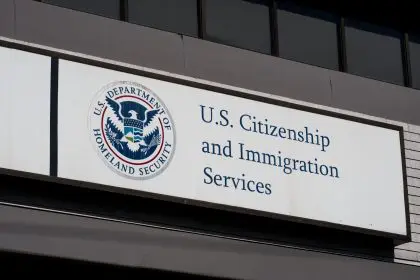A peaceful Monday afternoon in Laguna Beach turned into a nightmare for hundreds of residents when a brush fire, suspected to have been sparked by fireworks, forced emergency evacuations and sent the picturesque coastal community into crisis mode. The blaze, which ignited around 2:15 p.m. near Morningside Drive and Rancho Laguna Road, served as a stark reminder of how quickly fire danger can escalate in Southern California’s fire-prone landscape.
The incident unfolded with alarming speed, transforming what should have been an ordinary summer day into an emergency situation that mobilized multiple fire departments and prompted officials to order the evacuation of hundreds of homes in the Arch Beach Heights area. The rapid response from emergency services and the community’s swift evacuation likely prevented what could have been a much more devastating outcome.
What makes this fire particularly concerning for residents is not just its suspected cause, but its timing and location. The blaze occurred during a period when fire danger remains elevated throughout Southern California, and in an area where past fires have caused catastrophic damage to the community.
The fireworks connection that has residents concerned
The suspected link between fireworks and the Laguna Beach fire has raised serious questions about fire safety practices in the community. While the investigation into the fire’s exact cause continues, the preliminary finding that fireworks may have sparked the blaze has intensified discussions about preventing similar incidents in the future.
Fireworks-related fires represent a growing concern for fire departments across California, particularly during summer months when vegetation is dry and weather conditions can rapidly spread small fires into major emergencies. The Laguna Beach incident demonstrates how quickly a celebratory activity can turn into a community-wide crisis.
The timing of the fire, occurring on a Monday afternoon when many residents were going about their daily routines, caught many people off guard. The rapid escalation from initial spark to evacuation orders highlights the unpredictable nature of fire emergencies and the importance of community preparedness.
Local residents have expressed shock and concern about the fireworks connection, with many questioning how such incidents can be prevented in the future. The suspected cause has prompted discussions about fireworks regulations and enforcement in areas prone to wildfire danger.
Swift emergency response saves the day
The efficiency of the emergency response to the Laguna Beach fire played a crucial role in preventing a potential disaster. Fire departments mobilized quickly to contain the blaze, while evacuation orders were issued promptly to ensure resident safety during the critical early hours of the incident.
Captain Chip Gilmore from the Laguna Beach Fire Department reported that firefighters successfully established containment lines around the main body of the fire, preventing it from spreading beyond the initial 4-acre burn area. The quick establishment of these defensive lines proved critical in protecting nearby homes and structures.
The evacuation process, while disruptive for hundreds of families, proceeded smoothly thanks to established emergency protocols and community cooperation. Residents in the Arch Beach Heights area responded quickly to evacuation orders, allowing emergency services to focus on fire suppression rather than rescue operations.
The coordinated response between multiple agencies demonstrated the effectiveness of regional fire mutual aid agreements, with resources from surrounding communities contributing to the rapid containment effort. This collaboration proved essential in managing the incident during its most critical phase.
Community resilience tested once again
The Laguna Beach fire represents another test of community resilience for residents who have lived through previous fire emergencies. The evacuation and subsequent all-clear order within hours demonstrated both the ongoing fire risk in the area and the community’s ability to respond effectively to emergency situations.
Many residents experienced the stress and uncertainty that comes with evacuation orders, even though the situation was resolved relatively quickly. The emotional toll of packing essential belongings and leaving homes behind, even temporarily, serves as a reminder of the ongoing wildfire threat facing Southern California communities.
The rapid resolution of the evacuation orders, lifted at 7:30 p.m. Monday night, provided relief to affected families but also highlighted the unpredictable nature of fire emergencies. The quick transition from crisis to all-clear demonstrates how fire conditions can change rapidly with effective emergency response.
Community members have praised the professionalism and effectiveness of emergency responders, while also acknowledging the stress and disruption caused by the incident. The experience has reinforced the importance of emergency preparedness and the need for continued vigilance regarding fire safety.
Historical context adds urgency to fire concerns
The Laguna Beach fire occurred against a backdrop of significant historical fire events that have shaped the community’s relationship with wildfire risk. The memory of past disasters continues to influence how residents and officials respond to new fire threats.
The 1993 Laguna Fire remains a defining moment in the community’s history, having consumed 16,000 acres and destroyed over 4,000 homes. This catastrophic event established fire safety as a permanent concern for residents and influenced emergency preparedness planning for decades.
More recently, the 2021 Emerald Fire burned more than 150 acres along the northern edge of Laguna Beach, serving as a reminder that fire danger remains an ongoing threat. The relatively fresh memory of this incident likely contributed to the swift and serious response to Monday’s fire.
The historical pattern of fire events in the area has created a community that takes fire warnings seriously and maintains a high level of preparedness. This cultural awareness of fire risk likely contributed to the effective evacuation and response to the latest incident.
Infrastructure impacts and recovery efforts
The Laguna Beach fire caused several infrastructure disruptions that affected daily life for residents even beyond the immediate evacuation zone. Power outages occurred intermittently throughout the affected area, while road closures complicated traffic flow and emergency response efforts.
The power outages, while temporary, highlighted the vulnerability of utility infrastructure during fire emergencies. These disruptions affected businesses and residents throughout the area, demonstrating how fire incidents can have impacts that extend beyond the immediate burn area.
Road closures were implemented to ensure emergency vehicle access and resident safety during the most critical phases of the incident. While these closures caused inconvenience for residents and visitors, they proved essential for effective emergency response operations.
Recovery efforts began immediately after the fire was contained, with most streets reopened by Tuesday morning. The rapid restoration of normal operations demonstrated the effectiveness of emergency management protocols and the community’s ability to bounce back from crisis situations.
Lessons learned and future preparedness
The Laguna Beach fire incident provides valuable lessons for both residents and emergency services about fire preparedness and response. The suspected fireworks connection emphasizes the importance of understanding how everyday activities can contribute to fire risk.
The rapid escalation from initial spark to evacuation orders demonstrates the need for constant vigilance during fire season. Residents learned once again that fire conditions can change rapidly and that preparedness must be maintained throughout periods of elevated fire danger.
The effectiveness of the emergency response highlighted the value of established evacuation procedures and community cooperation. The smooth evacuation process and rapid containment efforts showed that preparedness investments pay dividends during actual emergencies.
The incident also reinforced the importance of maintaining adequate emergency resources and mutual aid agreements between fire departments. The successful response required coordination between multiple agencies and demonstrated the value of regional cooperation in fire management.
Moving forward with enhanced awareness
As Laguna Beach residents return to their normal routines, the Monday fire incident serves as a fresh reminder of the ongoing need for fire safety awareness and preparedness. The suspected fireworks connection has sparked renewed discussions about preventing similar incidents in the future.
The community’s experience with this latest fire emergency will likely influence future fire safety planning and education efforts. The rapid escalation and successful containment provide both cautionary lessons and examples of effective emergency response.
Residents are encouraged to review their emergency preparedness plans and ensure they are ready for future fire incidents. The Monday fire demonstrated that fire emergencies can develop quickly and that advance preparation is essential for family safety.
The incident also highlights the ongoing importance of fire prevention efforts, particularly regarding activities that can spark fires during high-risk periods. Community education about fire safety practices remains crucial for preventing future incidents.
Looking ahead to continued fire season
The Laguna Beach fire occurred during what is traditionally the peak of Southern California’s fire season, with dry conditions and warm weather creating elevated fire risk throughout the region. The incident serves as a reminder that fire danger remains high and that vigilance is required throughout the coming months.
Weather conditions and vegetation moisture levels will continue to influence fire risk in the area, requiring ongoing attention to fire safety practices. The community’s response to this incident provides a foundation for managing future fire threats during the remainder of the season.
Emergency services will continue monitoring conditions and maintaining readiness for additional fire incidents. The successful response to Monday’s fire demonstrates the effectiveness of current emergency preparedness systems while highlighting the need for continued vigilance.
The Laguna Beach fire incident, while relatively small and quickly contained, provided important lessons about fire safety, emergency response, and community resilience. As residents move forward, the experience will undoubtedly influence future fire preparedness efforts and reinforce the importance of maintaining constant awareness of fire risk in Southern California’s fire-prone environment.
















